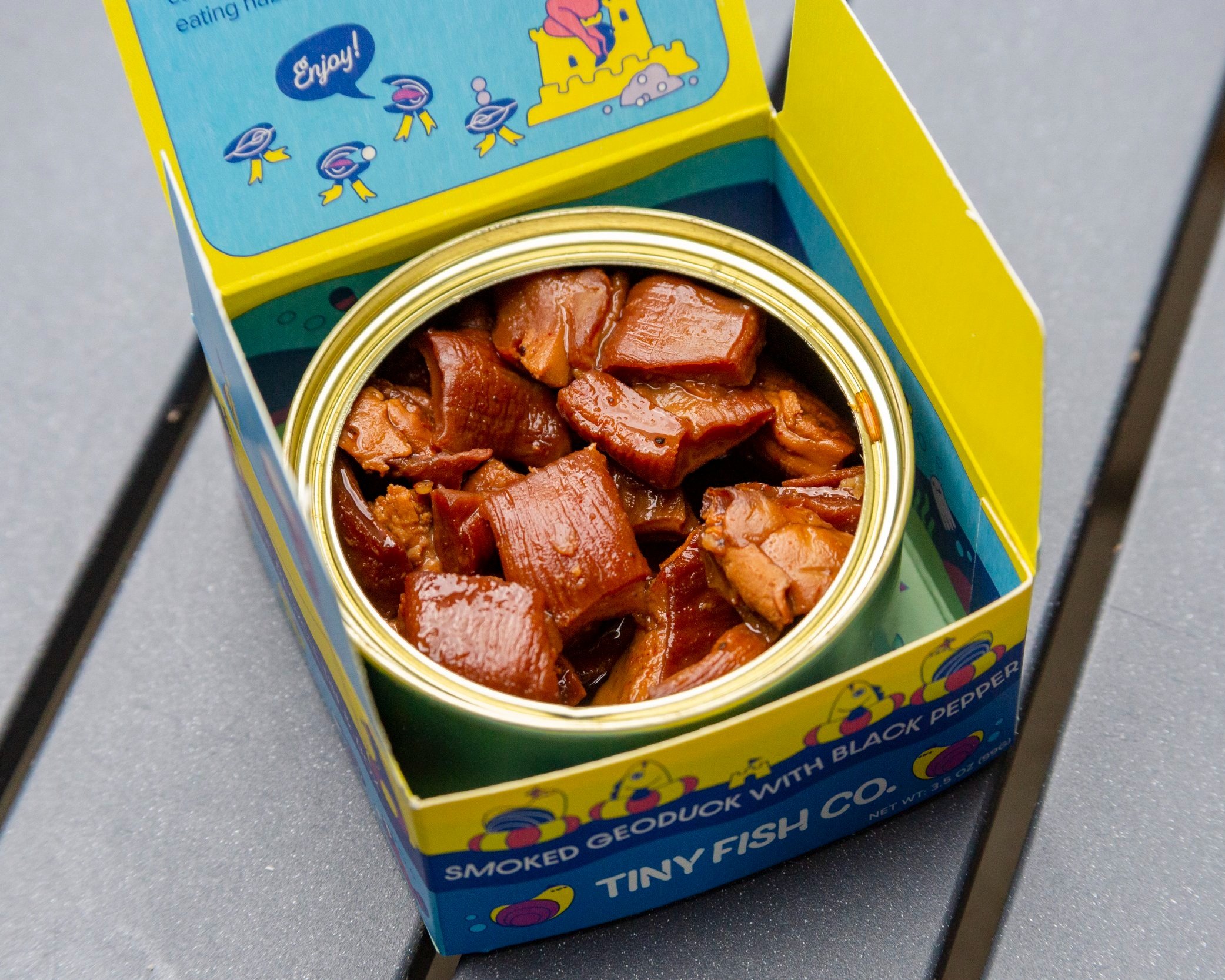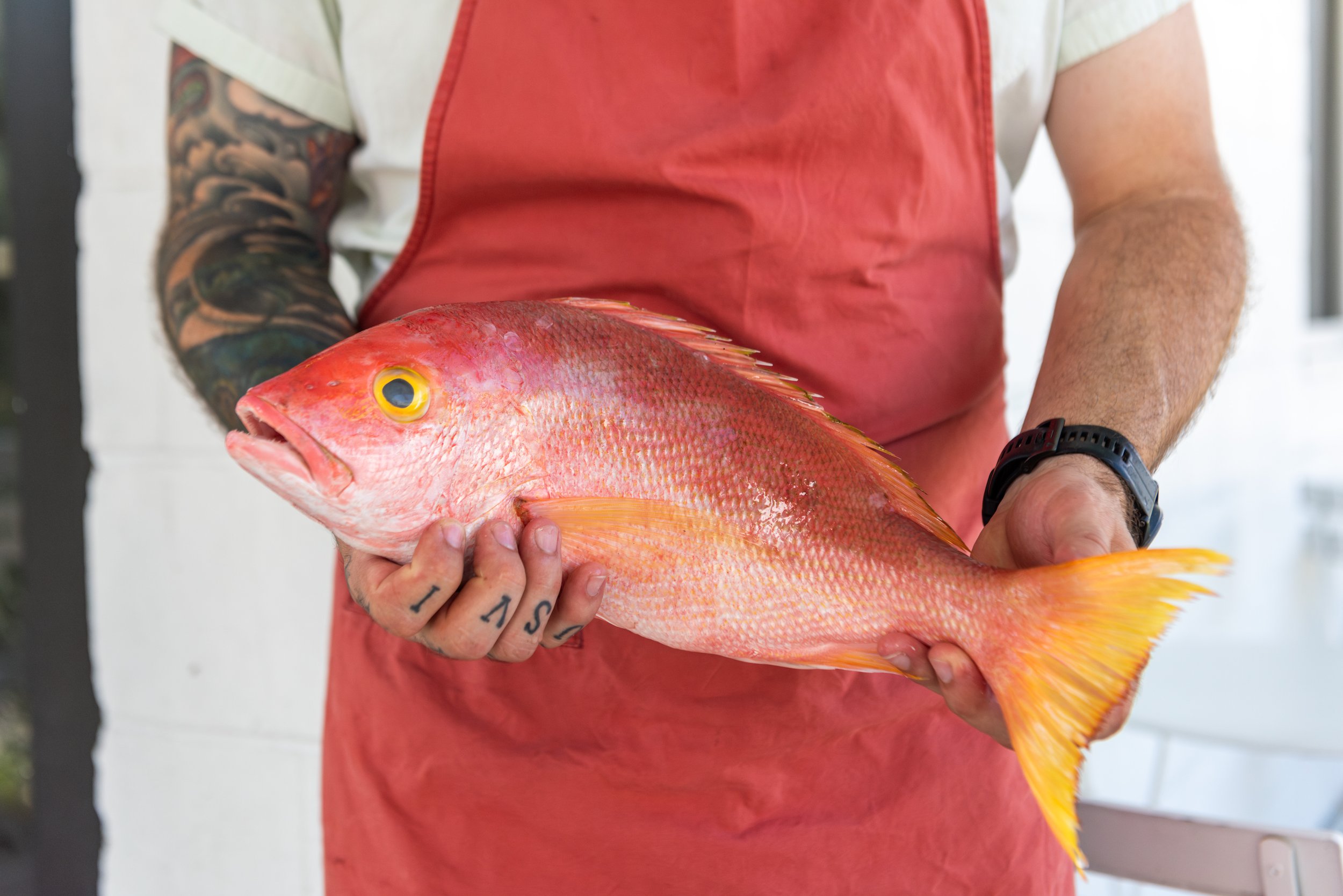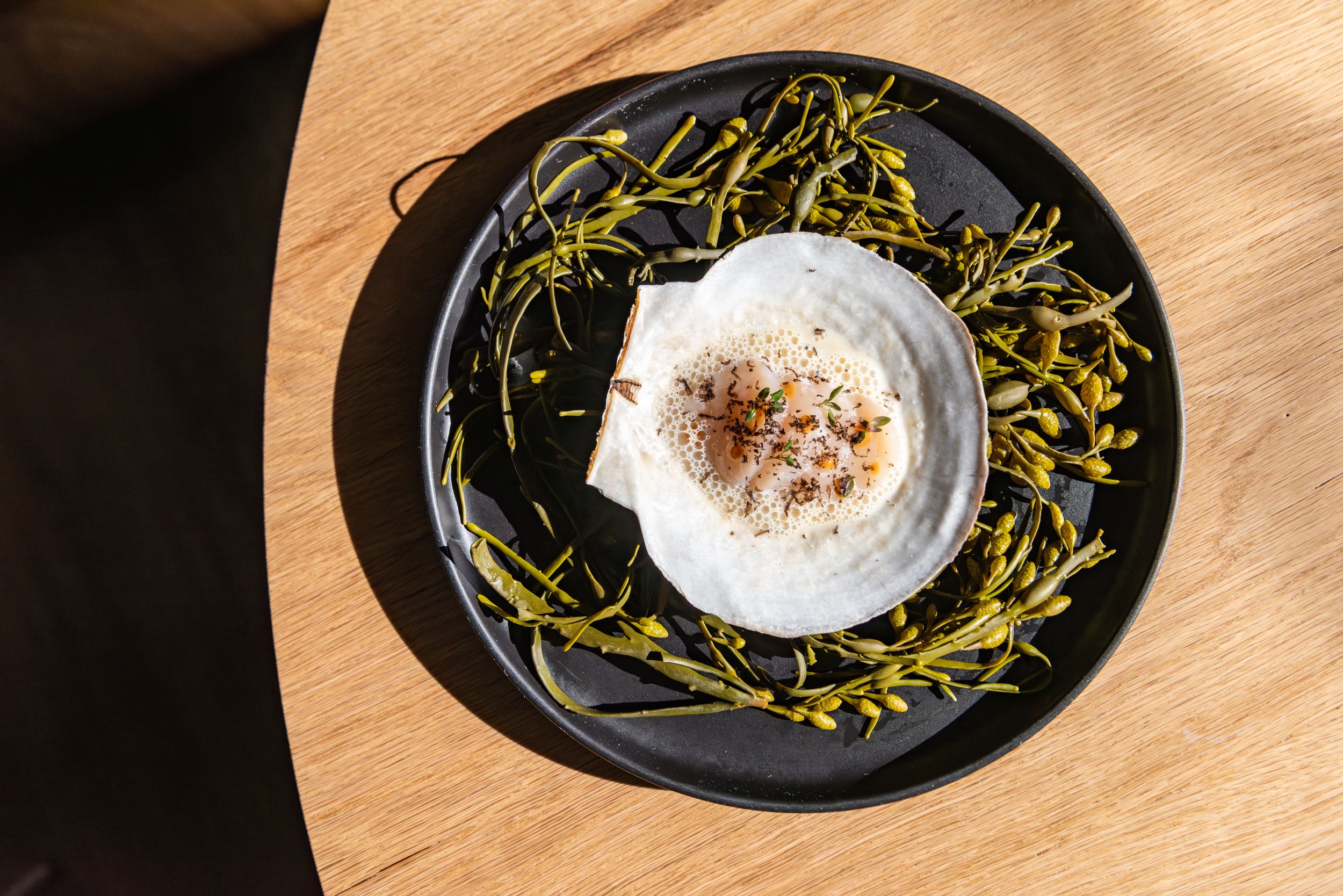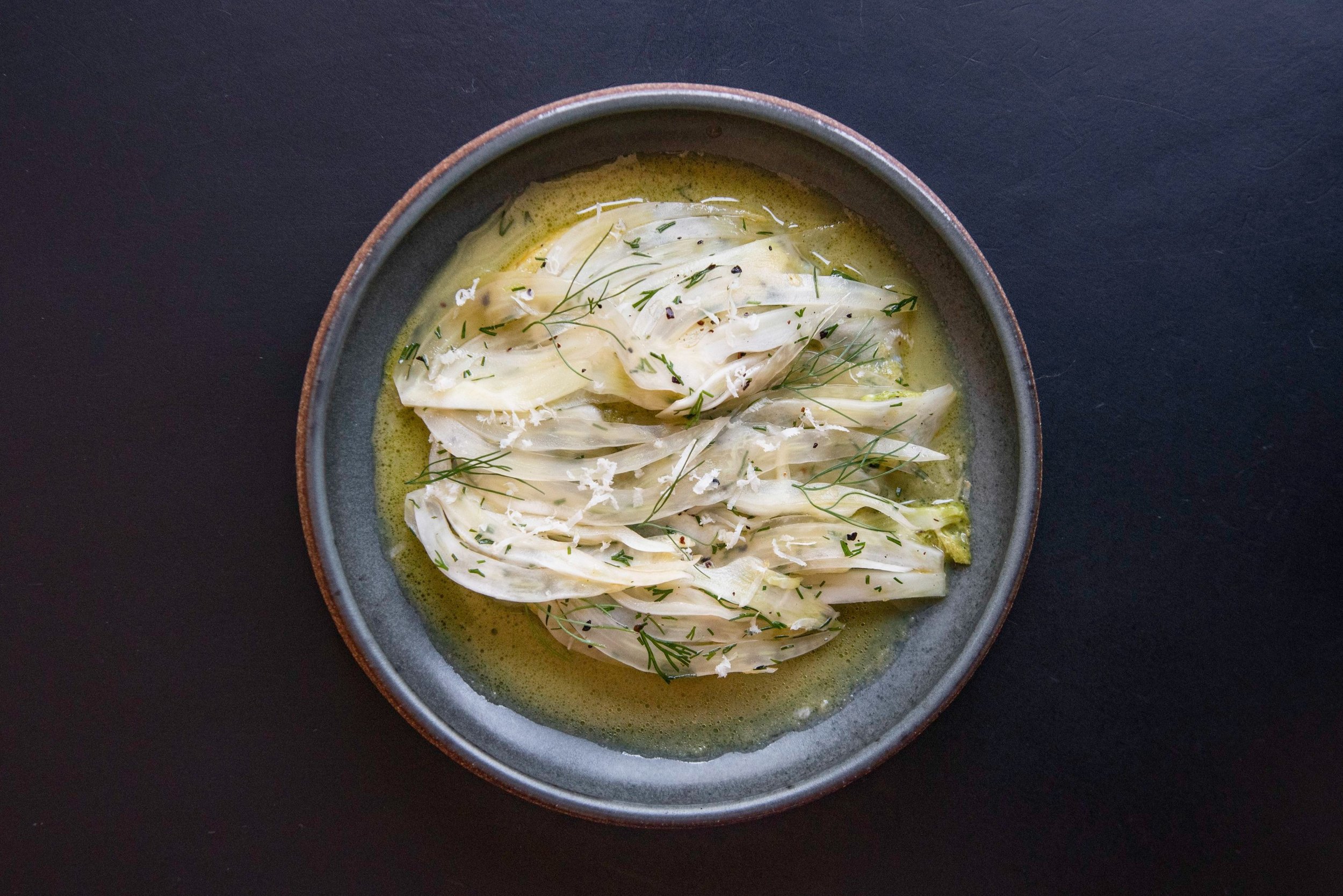Tin-Fueled Flavor
Chef Sara Hauman highlights sustainable fish and packs big flavor into tiny packages at Tiny Fish Co.
photos: raeann serra
Spanish conservas have long been a delicacy enjoyed around the world. But what if you combined this age-old preservation practice with sustainably caught fish and chef-driven flavors for a shelf stable product that reduces waste, supports local fisheries, makes use of bycatch and introduces diners to lesser-known species? Enter: Tiny Fish Co.
“No fish left behind” was Chef Sara Hauman’s mission when she founded Tiny Fish Co. in December 2021, a long-awaited dream after falling in love with conservas while working at Asador Etxebarri in Spain years earlier.
“I thought about fish all the time, and it just seemed so far-fetched to do that,” says Hauman about canning her own product.
So, how does one go from head chef to TV personality to owner of her own cannery business? It began when the San Francisco chef, who had earned her chops at Bar Agricole, Huxley, Octavia, and Mister Jiu’s, admits that something was still amiss, even among all the successes.
“I found myself at the head of kitchens, and while it was great, and challenging, and I had some accolades and whatnot, it never really made me happy,” she says. “I was very sad all the time, and I didn’t know what was wrong with me because I loved food and I loved cooking, so I thought maybe I just needed a complete change of scenery.”
That change came about when Hauman relocated to Portland, Oregon, landing at Arden and then at Soter Vineyards in Carlton. Then, in 2020, a producer for Top Chef asked her to join Season 18. “When I was on the show, they have you do like five million interviews. One day, they asked me what my dream was. The first thing that popped out of my mouth was that I wanted to own a boutique cannery one day, and they aired that for me, which was awesome.”
The pandemic was in full effect at the time, allowing her more time to explore her fish-focused ambitions, and the stars began to align when a close friend insisted on investing.
“I had no concept of the consumer packaged goods world; I’m coming at it from a chef’s perspective,” she says. “A co-packer in Willapa Bay, about two and a half hours northwest of Portland, asked me if I would be interested in doing some recipe development for their tinned fish, and I thought that would be pretty fun.” She told them about her vision and recent investments and “they said, ‘You know, why don’t you come up here, do your recipes, your research and development, and we can manufacture the product for you so you don’t have to buy all the equipment.”
Chef Sarah Hauman
smoked geoduck with black pepper
Things were definitely falling into place for Hauman, but she wasn’t about to just stuff some salmon or tuna into a can and call it a day. “It was more about how I could do something different. Being in the Pacific Northwest, we have an incredible abundance of seafood. Most of our fish on the West Coast is exported, so I wanted to figure out a way to support local fisheries and reduce waste.”
By sourcing locally caught, underutilized fish, Hauman gets the opportunity to introduce new flavors, while fisheries are able to sell bycatch they can’t always safely toss back. Take, for example, the giant Pacific octopus.
“The fishery I source bycatch octopus from uses pots as their commercial fishing method. It’s one of the most sustainable commercial fishing methods because it sits in the middle of the water column and doesn’t hit the seafloor with a big net. But sometimes giant Pacific octopus get caught. A lot of people throw them back in the water, but they often get injured when trapped, and even just one little nick or scratch on their body can be very detrimental to them in the wild. So you're really risking their life by throwing it back as opposed to selling it to people like me. I look at it as honoring their life. I’m preserving it so we can enjoy it for years.” Not to mention, the octopus is delicious, especially when paired with butter, lemon, and dill as Hauman offers it.
“The canning process involves cooking the product for a relatively long time under high heat and pressure” she says. Using fish species like octopus and clams that can tolerate longer cooking processes, or fish with higher fat content that retain moisture like salmon and tuna, works better. Since Hauman uses some underutilized seafood that tends to be leaner, she’ll add different fats like butter and olive oil.
Here's how the process goes: after the product is canned, the co-packer sends it back to her for taste testing. “After that, the products are sent to the lab to get tested and the cannery receives what is called a 'cook schedule.’ This tells them how long to cook the tins to ensure there is no bacterial growth.” In the meantime, Hauman sources her seafood and other raw materials and has it shipped to the cannery. Sometimes she’ll make the trek up to the cannery to drop off any “lighter load” supplies.
It all sounds straightforward on paper, but Hauman points out a few challenges. Sourcing can be tough, primarily because she uses only domestically harvested fish, which are often seasonal.
“The octopus I use is a bycatch of wild-caught cod fisheries in Alaska. This means that I not only have to wait for the cod fishing season to start, but I’m at the mercy of how much bycatch they actually bring in. A lot of times I have to commit to a specific quantity of fish before even knowing the price. It’s a tricky game to play, but I try to stay focused on my main mission: encouraging consumers to eat more 'climate friendly' fish species and supporting smaller fishing vessels.”
The challenge with using extra-fresh seafood means the fish has to be “pretty much ready to go into the tin” when it gets to the cannery. “If I want black cod without any skin, I have to specify that to the fishery before they process the fish, which is an added cost to me. Sometimes I have to source fish from multiple fisheries,” she says.
And, like restaurants, profit margins are thin. “This is another reason you see tinned fish companies either re-branding ‘white label’ products from Europe or outsourcing their canning and manufacturing to Europe or Mexico,” she says. “When I set out to create Tiny Fish Co. a huge part of my ethos was in creating community. Does this come at a cost? Absolutely. But I am hoping that the more I can talk about my products and create something unique, the more consumers will see the value in what looks just like any other ordinary can of fish.”
Hauman says she recently brought on a small, Portland-based distributor that will eventually take over her shipping and fulfillment needs that she currently handles herself. “I have been so lucky to have a great sales channel via my e-commerce and my website, as well as through online wholesale platforms, like Faire, that have allowed my products to essentially be distributed nationwide,” she says.
While Tiny Fish Co. products are available to consumers online and in specialty markets nationwide, Hauman has also collaborated with chef friends to use her products on restaurant menus. “That was one way I could connect the dots between the consumer product and culinary worlds. It’s a nice way to have chefs think about food differently.”
For Hauman, it’s all about balance and “promoting the diversity of what you’re eating—from the land and the sea,” she says. “Tuna and salmon are delicious, but they’re really the red meat of the ocean, and we don’t eat meat every day. There are plenty of other fish out there. The soul-satisfying part about it all is being able to educate people and hopefully make a positive impact on the environment and consumer choices. [To be able to] contribute to some sort of better future for us all—and to be able to do that through food.”









